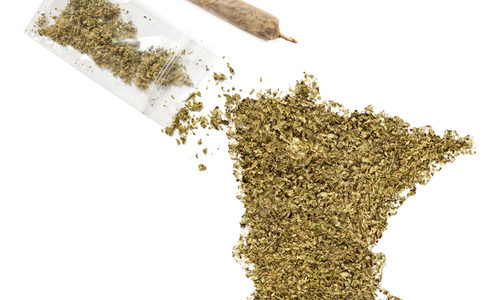Minnesota Inadvertently Allows Unregulated Intoxicating Cannabis Edible Products
Marijuana Industry NewsMinnesota July 6, 2022 MJ Shareholders 0


By Ian A. Stewart
As of July 1, 2022, unregulated intoxicating THC products derived from hemp have been legalized in Minnesota, apparently as the result of confusion by state legislators about the new law’s actual effect. Although the express intent of the statute is to allow the sale of products that contain so-called “non-intoxicating cannabinoids” to consumers in Minnesota, the new law contains a massive loophole that effectively legalizes all forms of THC sold in edible products at levels that intoxicate with only a bare minimum of regulatory oversight.
This surely cannot have been the goal of many Minnesota legislators who voted for the bill. In fact, the Minneapolis Star Tribune has reported that at least one senator in the state’s Republican-controlled Senate confirmed that he did not realize that the new law would legalize edible products with all forms of THC.
The Loophole
The new law changes section 151.72 of the Minnesota Statutes by defining “non-intoxicating cannabinoid” as “substances extracted from certified hemp plants that do not produce intoxicating effects when consumed by any route of administration.” The bill then incongruously allows for edible cannabinoid products to be sold to consumers in the state so long as the product contains no more than 0.3 percent of any THC and no more than 5 mg of any THC in a single serving, or more than a total of 50 mg of any THC per package.
Most states are now being forced to grapple with how to respond effectively to the problem of unregulated intoxicating hemp cannabinoids being sold openly and online. Edible products with intoxicating levels of hemp-derived delta-8 THC, delta-9 THC, delta-10 THC and THC-O Acetate are sold widely as legal and less-expensive alternatives to regulated marijuana products. States have employed various strategies to, by varying degrees, limit, regulate or prohibit intoxicating hemp cannabinoids, and lawsuits on the subject have been initiated in several states.
No state has created a loophole quite like what exists in Minnesota’s new law. Although Minnesota seeks, at least nominally, to only allow the sale of products that contain “non-intoxicating cannabinoids,” food and beverages that contain less than 0.3 percent THC concentration may nevertheless be intoxicating due to the large amounts that may be consumed easily.
To illustrate the problem of hemp products that contain less than 0.3 percent delta-9 THC concentration but are nevertheless intoxicating, consider this:
- A typical energy bar of 60 grams would be allowed to have up to 180 mg THC if limited to 0.3 percent THC concentration by weight.
- Regulated cannabis edible products, by comparison, typically may be sold only in a serving size of no more than 10 mg, with a limit of up to 100 mg per package.
- A four-gram hemp gummy product, however, could have 10 mg of THC and still fall below the allowable concentration threshold.
- Minnesota’s new law allows up to 5 mg THC per serving and 50 mg THC per package.
The intoxicating potential here is evident. One need only consume two servings to ingest the same amount of THC allowed in a standard regulated marijuana product serving. Ingesting 50 mg of THC will heavily intoxicate all but the most jaded stoner. Nowhere in the new law, however, is there any requirement to warn that the cannabis edible product may cause intoxication when consumed as suggested.
The Goal Informs the Solution
States should focus on the goal of prohibiting or properly regulating intoxicating hemp products that are currently sold as an unregulated and less-expensive alternative to regulated cannabis. We have previously warned that any state that decides to allow hemp-derived THC in edible products must necessarily grapple with tricky questions over how to regulate maximum serving size, active cannabinoid concentration per serving size, the number of servings per container, consumer warnings and similar questions to mitigate the risk to public health and safety. Cannabis and hemp industry leaders have likewise warned against “percentage” thresholds of cannabinoids as an appropriate measure for foods and beverages for the reasons described above.
In comparison to Minnesota, other states are proceeding in a more cautious manner. California’s recent Assembly Bill 45, for example, draws attention to the above-mentioned issues but acknowledges that more study is needed by the California Department of Public Health (CDPH) before implementing regulations are issued. The bill provides that CDPH “may regulate and restrict the cap on extract and may cap the amount of total THC concentration at the product level based on the product form, volume, number of servings, ratio of cannabinoids to THC in the product, or other factors, as needed.”
Analysis
Exacerbating the problem is the fact that product contamination, label inaccuracies and outright fraud are pervasive within the hemp cannabinoid market. Products often are marketed with misleading or false claims, and many fail to incorporate any explicit warning of intoxicating effects. Because the Minnesota statute incorrectly assumes that consumers will not become intoxicated from compliant edible cannabis products, no such warnings are mandated. This is a mistake.
It appears that better education around hemp-derived edible products could have led to more thoughtful legislation in Minnesota. This example may nevertheless provide a learning opportunity for other states that are studying how to regulate intoxicating hemp products.
MJ Shareholders
MJShareholders.com is the largest dedicated financial network and leading corporate communications firm serving the legal cannabis industry. Our network aims to connect public marijuana companies with these focused cannabis audiences across the US and Canada that are critical for growth: Short and long term cannabis investors Active funding sources Mainstream media Business leaders Cannabis consumers











No comments so far.
Be first to leave comment below.